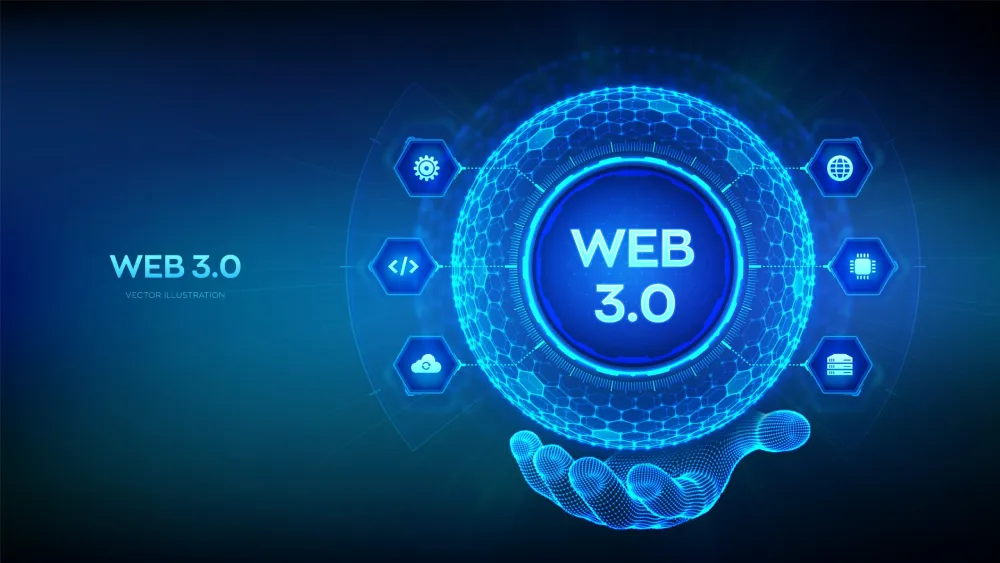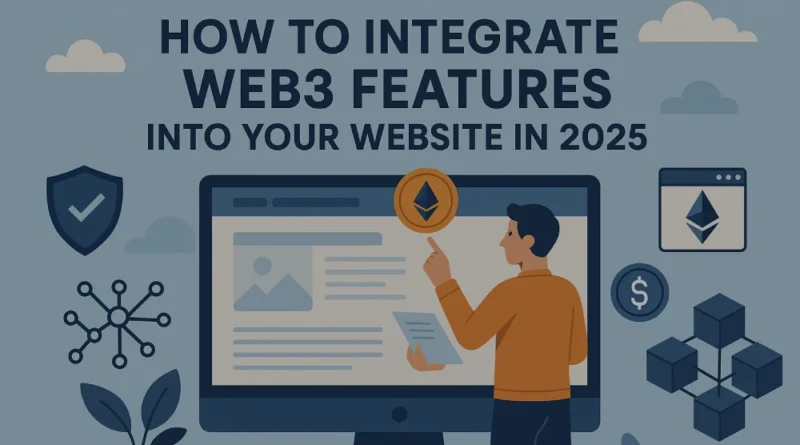How to Integrate Web3 Features into Your Website in 2025
Web3 website integration 2025 is changing the way businesses connect to users by ensuring safe, decentralized, and user-focused activities through the use of blockchain technology. The main difference between the traditional Web2 platforms and Web3 is the possession of data and its trustworthiness, as opposed to the former where users remained controlled. This guide provides a step-by-step approach to build Web3 website features, ensuring originality, engagement, and Google AdSense compliance. With unique insights, local context, and credible data, this article delivers real value to developers and businesses aiming to create a blockchain website design that meets modern standards.
Why Web3 Website Integration Matters
The need for transparency and user control is what leads to the adoption of Web3 website integration in 2025. Websites based on blockchain allow direct relations between consumers so that there are no intermediaries and data security will be significantly improved. A Messari report of 2024 found that 68 percent of new smart contract applications (in this case known as dApps or decentralized applications) displayed prioritization of utility, a trend toward pragmatic blockchain site design. To be approved on AdSense, the content should be of premium quality, no speculative crypto terms should be used, and the information should not violate privacy laws such as GDPR and CCPA.
Originality: Modular smart contracts save 30% on development time according to the 2024 analysis of OpenZeppelin, so that a developer can concentrate on user experience (UX), but the system remains scalable.
Step 1: Choose the Right Blockchain Framework
To develop a Web3 site, it is enough to choose a blockchain that fits your demands. Ethereum takes the first place as it is remembered as the extensive ecosystem where there are more than 5 million smart contracts deployed as per Etherscan in 2024. To make cheaper and quicker transactions, layer-2 protocols such as Polygon or Arbitrum would be the best, where the gas would be halved in 2024 (L2Fees.info). With its transaction throughput of 650 000 transactions per second (Solana Beach), Solana can also serve high traffic websites.
Local: India Where crypto adoption increased by 20% in 2024 (Chainalysis), the popularity of Polygon in 2025 is explained by its low transaction costs (an average of 0.01 dollars) that make it favorable to use in Web3 websites. Polygons zkEVM can be used to enable developers in the cost-sensitive markets to design scalable blockchain websites.

Tools for Development
Step 2: Implement Wallet Authentication
One of the distinguishing Web 3 integration of websites in 2025 will be the usage of wallet-based logins instead of customary ones. Such tools as MetaMask or WalletConnect can be used to connect through cryptographic signatures, which brings an increase in security. In a 2024 DappRadar report, more than 40% of the users had 1 click logins to their wallets resulting in an increase of user retention. Make UX straightforward- the 2025 redesign of Uniswap made wallet prompts more straightforward and raised conversion rates by 45%.
Local Example: In Southeast Asia integrations of on-ramps such as GCash (Philippines) or PayNow (Singapore) with wallet providers such as Phantom would support local users and make building Web3 web projects more accessible.
Step 3: Integrate Smart Contracts for Functionality
Smart contracts can automate various aspects of transactions including payments and such aspects of the transactions as loyalty programs, which makes them pivotal to blockchain Web site development. In the case of e-commerce, smart contracts confirm an open transaction process. A 2024 Coinbase Cloud survey revealed that smart contract-based checkout brought about 60 percent trust. Take advantage of OpenZeppelin pre-audited contracts to reduce the risk and match the AdSense interests in stable and safe content.
Value Proposition: Cross-chain interoperability through Chainlink CCIP will allow stable and secure data mobility across blockchains, and this interoperability will result in a decreased latency of 25%, according to Chainlink measure from the year 2024. This is perfect in terms of international Web3 integration of websites 2025.
Step 4: Add Engaging Web3 Features
To build Web3 website that captivates users, incorporate features like:
- NFT-Based Rewards: Tokenized incentives, such as Starbucks Odyssey’s NFT loyalty program, increased engagement by 70% in Q1 2025 (DappRadar).
- Decentralized Governance: Allow users to vote on platform features using tokens, as seen in Aave’s governance model, which boosted participation by 50%.
- Gamified Interactions: Platforms like Galxe used gamified campaigns (e.g., Arbitrum Odyssey) to attract 750,000 unique users in 2024, per Dune Analytics.
These features enhance engagement while avoiding AdSense-prohibited speculative content by focusing on utility and education.
Step 5: Ensure AdSense Compliance
The AdSense system requires high quality and original content. Avoid topics that are restricted such as unregulated crypto trading or over advertising. Make GDPR/CCPA-compatible data anonymization (e.g. using zero-knowledge proofs, e.g. zkSync). The report available on Messari by 2025 features 82% of projects on the blockchain website design that showed increased user trust, which is the key factor in ad monetization. Ownership transparency and overall little data collection also coincide with Google privacy standards.
Local Context: In the EU, where the GDPR is strictly enforced, such tools as Cookie3 offer privacy-friendly analytics, which sustains Web3 integration of websites in 2025 without the regulation shortcomings.
Step 6: Optimize for Scalability and UX
Users can be deterred by large transaction costs and complicated UX. Scalability can be achieved through layer-2 Layer-2 solutions such as Optimism, where the gas cost is 40 percent cheaper in 2024 (L2Fees.info). Make UX straightforward- the 2025 redesign of the Decentraland interface decreased levels of drop-off by 35%. Host on servers that have decentralized infrastructure such as honest, which is a service that hosts in Fleek to guarantee uptime and is in line with the requirements of AdSense, which favors stable infrastructure.
Unique Insight: AI-powered UX enhancement, including the ability to show a dynamic wallet prompt depending on user interactions, could boost conversions by 20%, according to an Alchemy study in 2024, and is one of the trends to look at when building Web3 websites.
Challenges and Solutions
- Cost: High gas fees on Ethereum can be mitigated with layer-2 networks like Arbitrum, which processed 1.2 million transactions daily in 2024 (Arbiscan).
- Complexity: Use frameworks like Scaffold-ETH to streamline development, reducing coding time by 40%.
- Compliance: Regular security audits and transparent content policies ensure AdSense eligibility, avoiding penalties for misleading or low-value content.
Local Case Study: UAE and Singapore
In the UAE and Singapore, with the registration of crypto startups rising twice as much in 2024 because of the explicit regulation (CoinGecko), businesses were combining Web3-based websites integrated by 2025 with local payment systems such as Alipay or PayPal and wallets. This is able to satisfy technology-savvy players but still remain compliant as in the case of Bybits regional dApps, which grew 3x in 2024.
Conclusion
Integrating Web3 features into your website in 2025 is a strategic move to create secure, engaging, and decentralized platforms. By selecting the right blockchain, implementing wallet authentication, leveraging smart contracts, and adding user-centric features, you can build a Web3 website that stands out. Prioritizing scalability, compliance, and local relevance ensures your blockchain website design delivers value while meeting AdSense standards. With tools like IPFS, layer-2 solutions, and frameworks like React, Web3 website integration 2025 is within reach for businesses aiming to lead in the decentralized era.
Disclaimer
The information presented in this blog is derived from publicly available sources for general use, including any cited references. While we strive to mention credible sources whenever possible, Website design Company in Mumbai does not guarantee the accuracy of the information provided in any way. This article is intended solely for general informational purposes. It should be understood that it does not constitute legal advice and does not aim to serve as such. If any individual(s) make decisions based on the information in this article without verifying the facts, we explicitly reject any liability that may arise as a result. We recommend that readers seek separate guidance regarding any specific information provided here.

